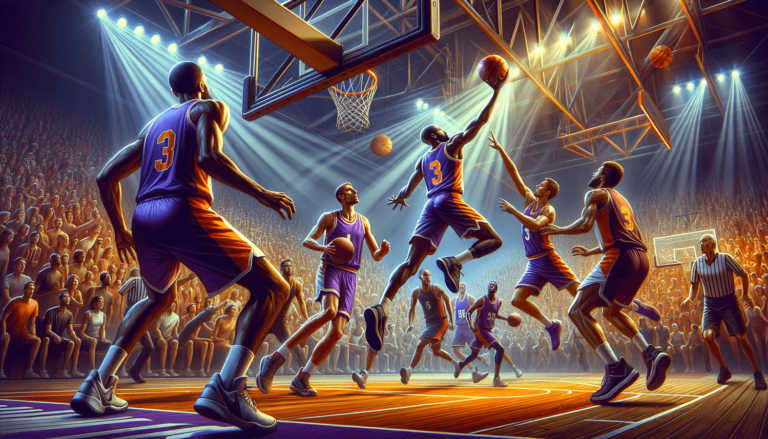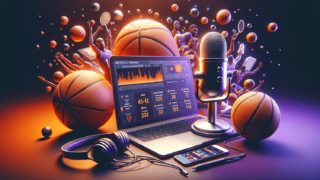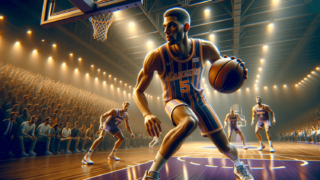
Welcome to the wonderfully dynamic world of basketball! This exciting, fast-paced game is as much about its diverse and skilled players as it is about the points scored. In this informative blog post, we’ll explore the five distinct positions that make up a basketball team – point guard, shooting guard, small forward, power forward, and center – dissecting their roles, responsibilities, and requirements. By the end of our hoop-tastic journey, you’ll be well-versed in not just the positions themselves, but also the incredible strategic interplay among them that keeps fans on the edges of their seats. Let’s dive in and discover the fine art of teamwork that lies at the heart of every thrilling dribble, pass, and slam dunk.
What Are the Positions in Basketball?
In basketball, there are five main positions: point guard (PG), shooting guard (SG), small forward (SF), power forward (PF), and center (C). Each position has specific roles and responsibilities, with the point guard acting as the team’s playmaker, the shooting guard focusing on scoring, the small forward playing as a versatile all-rounder, the power forward being a strong rebounder and inside scorer, and the center dominating in the paint with their size and shot-blocking abilities.
Unlocking the Secrets of the Basketball Court: Positions Explained
Imagine basketball as a perfectly choreographed dance, with each player showcasing their unique talents and skills to bring a mesmerizing spectacle to life. Taking a deep dive into each position, we will not only examine their core responsibilities but also how they contribute to the overall harmony and flow of the game. Let’s set the stage and explore the intricacies of basketball’s primary players.
The Floor General: Point Guard (PG)
Roles and Responsibilities
The point guard, often referred to as the floor general or the team’s quarterback, is the key playmaker and primary ball handler. They are responsible for setting up offensive plays, finding open teammates, and keeping the game tempo under control. On the defensive end, they use their quickness to pressure the opposing point guard, disrupt passing lanes, and force turnovers. Basketball aficionados know that these quick-thinking players can impact the game significantly.
Attributes and Skills
Point guards rely on exceptional ball-handling skills, lightning-fast reflexes, and strong decision-making abilities. They need remarkable court vision and a high basketball IQ to recognize openings, exploit opposing team weaknesses, and predict their teammates’ movements. Additionally, they are expected to have effective communication skills to direct their squad both offensively and defensively throughout the contest.
Iconic Point Guards
Some prominent examples of legendary point guards include Magic Johnson, John Stockton, and Steve Nash. In recent years, stars like Stephen Curry and Chris Paul have showcased the evolution of the position, blending playmaking with high-scoring ability and long-range shooting.
The Scoring Machine: Shooting Guard (SG)
Roles and Responsibilities
Enter the shooting guard, basketball’s scoring machine. These players are primarily responsible for putting points on the board, utilizing their shooting skills to convert from both inside and beyond the arc. Their scoring prowess can create space for the team’s other offensive weapons while also applying constant pressure on the opposition. Moreover, shooting guards contribute on the defensive end, using their athleticism and length to contest shots and stifle the rival backcourt.
Attributes and Skills
Shooting guards must have an arsenal of offensive skills, including precision shooting, proficient dribbling, and adept finishing at the rim. They routinely employ a mix of off-the-ball movement, effective screens, and pick-and-roll plays to ensure scoring opportunities. On the defensive side, their agility, speed, and lateral quickness prove invaluable when it comes to staying in front of the opposition and contesting shots.
Iconic Shooting Guards
When discussing the greatest shooting guards in basketball history, names like Michael Jordan, Kobe Bryant, and Dwyane Wade dominate the conversation. These legends mastered the art of scoring while contributing massively in playmaking, rebounding, and defensive efforts, setting an insurmountable benchmark for generations to come.
The Versatile Maestro: Small Forward (SF)
Roles and Responsibilities
Among basketball positions, the small forward is perhaps the most versatile, functioning as an all-rounder whose responsibilities encompass various aspects of the game. Working methodically to balance offense and defense, these adaptable players aid in both scoring and playmaking while often guarding the opposing team’s most potent offensive weapon. Their unpredictable nature and ability to switch roles on the fly keep opponents on their toes throughout the game.
Attributes and Skills
Small forwards excel by blending size, skill, and athleticism. They adapt to a wide array of game scenarios, thanks to their strong dribbling, shooting, and slashing capabilities on offense. Additionally, they need exceptional defensive expertise and the ability to play both perimeter and post defense. Small forwards must also possess solid rebounding skills, particularly on the defensive end, to help control the pace of the game.
Iconic Small Forwards
Legendary small forwards include Larry Bird and Julius “Dr. J” Erving. LeBron James and Kevin Durant, two modern-day titans, exemplify the position’s evolution by demonstrating unprecedented skill sets that extend far beyond the traditional small forward role, often functioning as primary scorers, creators, and defenders within their respective teams.
The Hardworking Enforcer: Power Forward (PF)
Roles and Responsibilities
Power forwards are the enforcers of the basketball court, known for their physicality, aggression, and relentless pursuit of rebounds. With their focus on interior scoring and strong inside presence, these players establish a harmony between their backcourt teammates and the center position. Power forwards also contribute on the defensive end by denying access to the paint, contesting shots, and securing crucial rebounds.
Attributes and Skills
Strength and stamina are vital to a power forward’s success, as these players routinely engage in tough battles for rebounds and interior positioning. Their offensive skills encompass an array of post moves, mid-range jumpers, and the occasional three-point shot. Furthermore, their role demands superior footwork, exceptional timing, and quick reflexes to be effective in shot-blocking and interior defense.
Iconic Power Forwards
Notable power forwards in basketball history include Tim Duncan, Karl Malone, and Charles Barkley. Contemporary examples like Dirk Nowitzki and Anthony Davis signal a new era for the position, with modern power forwards straying further from the basket and developing reliable long-range shooting abilities.
The Towering Anchor: Center (C)
Roles and Responsibilities
As the tallest, most imposing presence on the court, the center serves as the team’s anchor on both ends of the floor. Primarily responsible for securing rebounds, providing interior scoring, and deterring penetration with their shot-blocking prowess, centers dominate in the paint. Despite primarily operating near the rim, centers occasionally facilitate the offense and instantly alter the game’s dynamics with their overwhelming presence.
Attributes and Skills
Unsurprisingly, height and strength define the ideal center, equipping them to tower over opponents during rebounds and shot contests. Offensively, centers utilize hook shots, dunks, and low-post moves to create high-percentage scoring opportunities. On the defensive side, their main mission is to protect the basket, using their height and vertical reach to obstruct opponents’ paths and effectively challenge attempted shots.
Iconic Centers
Some of the all-time great centers include Bill Russell, Wilt Chamberlain, Kareem Abdul-Jabbar, and Shaquille O’Neal. These giants of basketball left indelible marks on the sport due to their remarkable interior play and their uncanny ability to alter the game’s dynamics whenever they stepped onto the court.
Understanding the Synergy of Positions in Basketball
After delving into the distinct roles, responsibilities, and skill sets of each position, their interconnectedness within the game becomes clearer. The point guard sets the tempo, the shooting guard applies offensive pressure, the small forward bridges gaps across the court, the power forward exhibits grit and tenacity, and the center anchors the team. This harmony of roles creates an on-court synergy that elevates basketball from a simple competition to a stunning athletic display of unity and collaboration.
The Evolution of Basketball Positions
Over the years, basketball has undergone substantial changes, impacting both the athletes and the way they play the game. Consequently, the traditional understanding of positions has evolved as player skill sets and coaching philosophies adapt to the ever-shifting landscape. In this section, we’ll delve into the positionless basketball trend, the rise of hybrid players, and the impact of these changes on the modern game.
Positionless Basketball: A Tectonic Shift
What is Positionless Basketball?
Positionless basketball refers to a style of play that moves away from the conventional roles and rigid structure associated with the five traditional positions. Instead, players assume fluid, interchangeable roles based on their abilities and situational matchups. This approach seeks to exploit mismatches, increase player versatility, and foster the development of well-rounded athletes who can excel in multiple aspects of basketball.
How it Affects the Game
The rise of positionless basketball has led to a new breed of multifaceted players who threaten opponents through their diverse skill sets. Teams are now prioritizing length, athleticism, and shooting ability over size and strength—emphasizing speed and floor spacing to create scoring opportunities. The harmonious blend of various player capabilities engenders a faster and more dynamic game, making it exceedingly difficult for defenses to adapt and effectively guard against these unpredictable offenses.
Hybrid Players: The Future of Basketball
Hybrid players epitomize the union of size, skill, and versatility in the modern game. Capable of playing multiple positions and adeptly handling various responsibilities, these athletes have altered the fabric of basketball and paved the way for a generation of dynamic, adaptable players who can exploit opposing defenses to their advantage.
Notable Hybrid Players
Two prime examples of hybrid player success are LeBron James and Draymond Green. Both of these exceptional talents defy position labels, shining as true chameleons on the court. LeBron’s incredible physical makeup, combined with his keen court vision and playmaking skills, allows him to seamlessly shift between the forward and guard positions, while Green’s unique skill set, including elite defensive skills and versatility, makes him a perfect fit for the modern game.
Embracing the New Age of Basketball
As basketball continually evolves, so does our understanding of the roles, responsibilities, and skill sets required to excel at the elite level. In the age of positionless basketball and hybrid players, the game has become faster, more dynamic, and increasingly thrilling. By celebrating these innovations and embracing change, we can better appreciate the beauty of basketball and the incredible influence these athletes have on shaping the sport’s future.
Frequently Asked Questions (FAQ)
Let’s address some of the most common questions regarding basketball positions, their roles, and the game’s evolution. This FAQ section is designed to provide quick insights into the fascinating world of basketball, so you can advance your understanding and enjoy the game even more.
1. What is the difference between a point guard and a shooting guard?
While both are part of the backcourt, the point guard is mainly responsible for playmaking and setting up the offense, while the shooting guard primarily focuses on scoring. Point guards rely on ball-handling skills and court vision, whereas shooting guards boast strong shooting and driving abilities.
2. Can a small forward also play as a shooting guard or power forward?
Yes, small forwards are often considered the most versatile players on the court and can comfortably slide between different positions on both offense and defense, depending on the matchups and their particular skill sets.
3. What makes a good power forward?
A good power forward excels at interior scoring, rebounding, and post defense. They make use of their strength, footwork, and offensive capabilities to create opportunities for easy baskets and support their team on both ends of the court.
4. Why are centers usually the tallest players on the team?
As the primary shot-blockers and anchors of the team, centers require height and size to contest shots effectively, secure rebounds, and dominate the paint on both offense and defense.
5. Are there specific height requirements for each position?
While there are no specific height requirements, certain physical attributes often align with traditional basketball positions. For instance, point guards are usually shorter and quicker, while centers are generally the tallest players on the team.
6. How many positions are there in a standard basketball lineup?
A standard basketball lineup comprises five positions: point guard, shooting guard, small forward, power forward, and center.
7. What is positionless basketball?
Positionless basketball refers to a playing style that disregards the traditional structure and roles of the five positions, emphasizing versatility, fluidity, and exploiting mismatches through interchangeable player roles.
8. How have basketball positions evolved over time?
Basketball positions have evolved in response to changes in player skill sets, coaching philosophies, and overall game speed. The emergence of hybrid players and positionless basketball has led to a blending of roles and an emphasis on versatility.
9. Can a player switch positions during a game?
Yes, many players can switch positions during a game, depending on matchups, player skill sets, coaching strategies, and lineup changes. This adaptability is one of the core components of modern basketball.
10. Are there any position-specific rules?
No, there are not position-specific rules in basketball. However, certain roles and responsibilities are commonly assigned to each position, which shape the overall playstyle and strategy of a team.
11. Can a center also play as a point guard?
While unconventional, it is possible for a highly skilled center with exceptional ball-handling, passing, and decision-making attributes to function as a point guard. The modern game has witnessed several big men with point guard-like abilities, such as Nikola Jokic and Al Horford.
12. How important is the bench in modern basketball?
The bench plays a crucial role in modern basketball, providing depth, rotational flexibility, and the ability to experiment with various lineup combinations. Strong bench players can maintain momentum, relieve starters, and contribute to overall team success.
13. How do coaches decide which players play which positions?
Coaches typically consider various factors, such as player skill sets, size, athleticism, basketball IQ, and team needs when deciding positions. Additionally, coaches may adapt positions and lineups based on game situations, matchups, and evolving strategies.
Featured Posts
- No pillar pages found.





